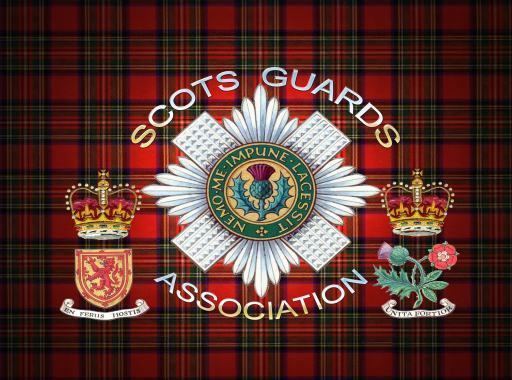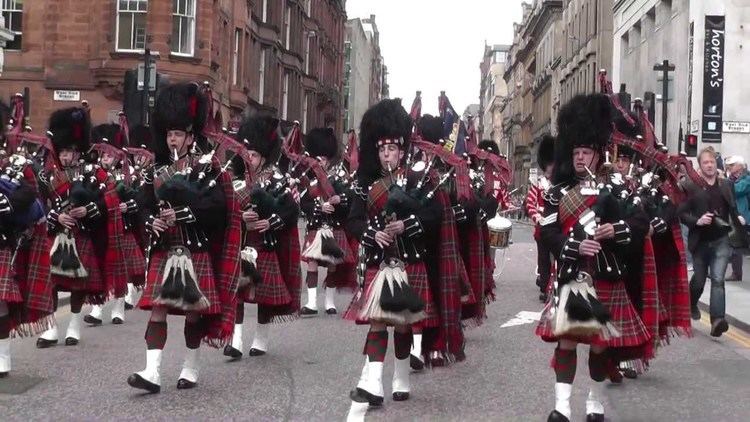Active 1642–16511661–present | ||
 | ||
Country Size One battalionOne company Similar Irish Guards, Grenadier Guards, Welsh Guards | ||
1st battalion scots guards homecoming parade glasgow 2013
The Scots Guards (SG), part of the Guards Division, is one of the Foot Guards regiments of the British Army. Their origins lie in the personal bodyguard of King Charles I of England and Scotland. Its lineage can be traced as far back as 1642, although it was only placed on the English Establishment (thus becoming part of what is now the British Army) in 1686.
Contents
- 1st battalion scots guards homecoming parade glasgow 2013
- F company scots guards
- 16421804
- 18051913
- The First World War
- The Second World War
- Since 1946
- Traditions and affiliations
- Role
- Training
- Regimental colonels
- Battle honours
- Alliances
- References

F company scots guards
1642–1804

The Scots Guards trace their origins back to 1642 when, by order of King Charles I, the regiment was raised by Archibald Campbell, 1st Marquess of Argyll for service in Ireland, and was known as the Marquis of Argyll's Royal Regiment.
It spent a number of years there and performed a variety of duties, but in the mid-1640s, during the Wars of the Three Kingdoms, the regiment took part in the fight against James Graham, 1st Marquess of Montrose who was fighting on the side of Charles I.
1805–1913

In April 1809 the 1st Battalion made their way to the Iberian Peninsula where they were to take part in the Peninsular War in Portugal and Spain. On 12 May 1809, the 1st Battalion took part in the crossing of the River Douro, an operation that ended so successfully that the French Army were in full retreat to Amarante after the actions in Oporto and its surrounding areas. In late July 1809 the regiment took part in the Battle of Talavera, one of the bloodiest and most bitter of engagements during the war.
The 2nd Battalion's flank companies took part in the disastrous Walcheren Campaign in the Low Countries. The 1st Battalion went on to take part in the Battle of Fuentes de Oñoro in May 1811, the Battle of Salamanca in July 1812, the Siege of San Sebastián in Summer 1813 and the Battle of the Nive in December 1813.
At the Battle of Waterloo in June 1815, the Scots Guards were positioned on the ridge just behind Hougoumont Farm, while the light companies of the two battalions, under the command of Lieutenant-Colonel James Macdonnell, garrisoned the Farm, a place on the right flank of the British and Allied army that would be a key position during the battle.
The First World War
The 1st Battalion, part of the 1st (Guards) Brigade of the 1st Division, was part of the British Expeditionary Force which arrived in France in 1914. The Battalion took part in the Battle of Mons in August 1914, the First Battle of the Marne in September 1914 and the Battle of the Aisne also in September 1914. The 1st and 2nd Battalions then took part in the First Battle of Ypres in November 1914, the Battle of Aubers Ridge in May 1915 and the Battle of Loos in September 1915. In July 1916 the Scots Guards took part in the first Battle of the Somme and in July 1917, the regiment began its involvement in the Battle of Passchendaele. In March 1918 they fought at the second Battle of the Somme and in Autumn the regiment took part in the final battles of the war on the Western Front.
The Second World War
In April 1940, the 1st Battalion, as part of the 24th Guards Brigade, took part in its first campaign of the war, during the expedition to Norway. In North Africa, as part of the 22nd Guards Brigade, the 2nd Battalion took part in fighting against the Italians in Egypt followed by tough fighting in Libya, then also controlled by Italy. In North Africa, in March 1943, the 2nd Battalion took part in the defensive Battle of Medenine, after the Germans had counter-attacked the Allies.
In September 1943, the 2nd Battalion, as part of the 201st Guards Brigade of the 56th (London) Division, took part in the Landing at Salerno. In December 1943, the 1st Battalion, as part of 24th Guards Brigade, arrived in the Italian Theatre. At the Battle of Monte Cassino in early 1944, the 2nd Battalion suffered heavy casualties in tough fighting.
The 1st Battalion, as part of its brigade, joined the 6th South African Armoured Division in May 1944. The regiment took part in many fierce engagements throughout 1944, including those against the Gothic Line, a formidable defensive line.
Since 1946
The 2nd Battalion was once more involved in war when it deployed to Malaya during the Malayan Emergency. Then in late 1951, the 1st Battalion was deployed to Cyprus and in February 1952, the battalion deployed to the Suez Canal Zone, Egypt. Both the 1st and 2nd Battalion deployed to Northern Ireland during the Troubles in the early 1970s.
During the Falklands War in 1982 the main force of the Scots Guards began its advance on the western side of Mount Tumbledown. During the course of the battle in the early hours of 14 June 1982, men of the 2nd Battalion launched a bayonet charge on the stout Argentinian defenders which resulted in bitter and bloody fighting, and was one of the last bayonet charges by the British Army.
In 2004 the 1st Battalion deployed to Iraq on a 6-month posting as part of 4th Armoured Brigade. The 4th Brigade relieved 1st Mechanised Brigade, and joined the Multi-National Division (South East), which was under UK command.
Traditions and affiliations
The Scots Guards and other Guards Regiments have a long-standing connection to The Parachute Regiment. Guardsman who have Completed P company are Transferred into the Guards Parachute Platoon who are currently attached to 3 PARA still keeping the tradition of the No 1 (Guards) Independent Parachute Company who were the original Pathfinder Group of 16th Parachute Brigade now renamed 16th Air Assault Brigade.
The Scots Guards is ranked as the third regiment in the Guards Division; as such, Scots Guardsmen can be recognised by having the buttons on their tunics spaced in threes.
Role
The regiment consists of a single operational battalion, which was based in Catterick between 2008 and 2015, thereafter moving to Aldershot in the armoured infantry role. However, since 1993, the regiment has also maintained an independent company, F Company, permanently based in Wellington Barracks, London on Public Duties. It is the custodian of the colours and traditions of the 2nd Battalion, which was placed in permanent suspended animation in 1993 as a result of Options for Change. 1st Battalion will be equipped with Mastiff Vehicles (and later the Mechanised Infantry Vehicle (MIV)) under Army 2020 and be under 12th Armoured Infantry Brigade.
Training
Recruits to the Guards Division go through a thirty-week gruelling training programme at the Infantry Training Centre (ITC). The training is two weeks more than the training for the Regular line infantry regiments of the British Army; the extra training, carried out throughout the course, is devoted to drill and ceremonies.
Regimental colonels
Regimental colonels have included:
Battle honours
The battle honours of the Scots Guards are as follows:
